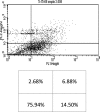Arsenic trioxide enhances the cytotoxic effect of thalidomide in a KG-1a human acute mylogenous leukemia cell line
- PMID: 21442015
- PMCID: PMC3062976
- DOI: 10.3892/ol_00000083
Arsenic trioxide enhances the cytotoxic effect of thalidomide in a KG-1a human acute mylogenous leukemia cell line
Abstract
Studies have shown that thalidomide exerts modest activity as a single agent in the therapy of acute myeloid leukemia (AML). The present investigation was conducted to test the hypothesis that the cytotoxic effect of thalidomide is enhanced when properly combined with other chemotherapeutic agents. The human AML cell line KG-1a was used in this study. Cells were cultured for 48 h in the presence or absence of thalidomide, arsenic trioxide and a combination of the two substances. Results obtained indicate that thalidomide at concentrations of 1, 2 and 5 mg/l produced a dose-dependent cytotoxic effect and at 5 mg/ml resulted in late apoptosis in 49.39% of the total cell population (as compared to 5.35% in the control cells). When the cells were incubated with arsenic trioxide alone (4 µM), late apoptosis was detected in 16.97% of the total cell population. However, when cells were incubated with a combination of thalidomide (5 mg/l) and arsenic trioxide (4 µM), late apoptosis was noted to be 80.6% in the total cell population. This percentage of late apoptosis was statistically significant from that observed when cells were incubated with thalidomide alone. These findings clearly indicate that arsenic trioxide enhances the cytotoxic effects of thalidomide.
Figures







Similar articles
-
Effect of thalidomide and arsenic trioxide on the release of tumor necrosis factor-α and vascular endothelial growth factor from the KG-1a human acute myelogenous leukemia cell line.Oncol Lett. 2010 Jul;1(4):663-667. doi: 10.3892/ol_00000116. Epub 2010 Jul 1. Oncol Lett. 2010. PMID: 22966360 Free PMC article.
-
Inhibitory Effects of Arsenic Trioxide and Thalidomide on Angiogenesis and Vascular Endothelial Growth Factor Expression in Leukemia Cells.Asian Pac J Cancer Prev. 2018 Apr 27;19(4):1127-1134. doi: 10.22034/APJCP.2018.19.4.1127. Asian Pac J Cancer Prev. 2018. PMID: 29699374 Free PMC article.
-
Low-dose arsenic trioxide combined with aclacinomycin A synergistically enhances the cytotoxic effect on human acute myelogenous leukemia cell lines by induction of apoptosis.Leuk Lymphoma. 2015;56(11):3159-67. doi: 10.3109/10428194.2015.1011155. Epub 2015 Jun 19. Leuk Lymphoma. 2015. PMID: 25739941
-
Arsenic-induced apoptosis in malignant cells in vitro.Leuk Lymphoma. 2000 Mar;37(1-2):53-63. doi: 10.3109/10428190009057628. Leuk Lymphoma. 2000. PMID: 10721769 Review.
-
Use of arsenic trioxide in haematological malignancies: insight into the clinical development of a novel agent.Curr Med Res Opin. 2005 Mar;21(3):403-11. doi: 10.1185/030079904X20349. Curr Med Res Opin. 2005. PMID: 15811209 Review.
Cited by
-
Reshaping the tumor microenvironment: The versatility of immunomodulatory drugs in B-cell neoplasms.Front Immunol. 2022 Oct 12;13:1017990. doi: 10.3389/fimmu.2022.1017990. eCollection 2022. Front Immunol. 2022. PMID: 36311747 Free PMC article. Review.
-
Effects of thalidomide on growth and VEGF-A expression in SW480 colon cancer cells.Oncol Lett. 2018 Mar;15(3):3313-3320. doi: 10.3892/ol.2017.7645. Epub 2017 Dec 19. Oncol Lett. 2018. PMID: 29435073 Free PMC article.
References
-
- Godwin JE, Smith SE. Acute myeloid leukemia in the older patient. Crit Rev Oncol Hematol. 2003;48:S17–S26. - PubMed
-
- Harousseuau JL. Acute myeloid leukemia in the elderly. Blood Rev. 1988;12:145–153. - PubMed
-
- Cortes JE, Kantarjian HM. Acute lymphocytic leukemia: A comprehensive review with emphasis on biology and therapy. Cancer. 1995;76:2393–2417. - PubMed
-
- Estey EH, Kantarjian H, Keating MJ. Therapy for acute myeloid leukemia. In: Hoffman R, Benz E Jr, Shattil S, Cohen H, Silberstein L, editors. Hematology: Basic Principles and Practice. 2nd edition. Churchill Livingstone; New York: 1994. pp. 1014–1028.
-
- Thomas DA, Kantarjian H, Smith TL. Primary refractory and relapsed adult acute lymphoblastic leukemia: characteristics, treatment results, and prognosis with salvage therapy. Cancer. 1999;86:1216–1230. - PubMed
Grants and funding
LinkOut - more resources
Full Text Sources
